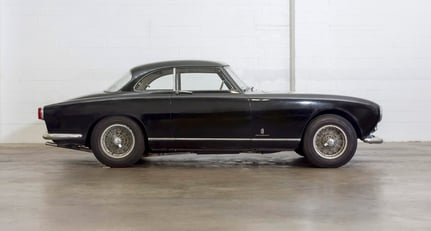1953 Ferrari 212
INTER PININ FARINA COUPE-
Year of manufacture1953
-
Car typeCoupé
-
Chassis number0269EU/0387GT
-
Lot number132
-
DriveLHD
-
ConditionOriginal Condition
-
Interior colourGrey
-
Interior typeLeather
-
Number of seats2
-
Location

-
Exterior colourBlue
-
GearboxManual
-
Drivetrain2wd
-
Fuel typePetrol
Description
A FERRARI WITH ROYAL PROVENANCE
-Unique & Unrivaled Provenance
-Extensive Public History And Documentation
-One Of Approx. 78-84 212’s Produced
-One Of 14 Coupes Bodied By Pinin Farina
-Leather Interior Thought To Be Original
-Exterior Paint With Lovely Patina Also Considered Original
This famous 212 Inter coupe was sold first to Prince Bernhard of the Netherlands, husband of Queen Juliana. In WWII, he served valiantly as a Wing Commander in the RAF, fighting with honor in the Allied defeat of Nazi Germany, and gaining world-wide respect for it. The Prince was an early and fervent fan of Ferrari, owning numerous models. As a Royal, as well as a good friend of Enzo, he got very special treatment from the factory. He was among the very first leaders of state and industry for which Ferrari would take custom orders. This 212 is the first fruit of the new collaboration between Ferrari and Battista, “Pinin” Farina, giving it even more historic significance to go with its royal provenance. There will not be another Ferrari with these credentials when it glides onto the Concours lawn.
THIS CAR’S PAST
This wonderful Ferrari was originally delivered to Prince Bernhard of the Netherlands. The Prince was said to be “mad about Ferraris,” after purchasing his first Ferrari second-hand from a Belgian owner in the early 1950’s. To make sure that the Prince was, in-fact, a satisfied customer, Ferrari is rumored to have sent two mechanics to check out the present car and update it to a more “modern” standard. Other sources indicate that the Prince received an all-new car with an order from Enzo to use the chassis number from the Prince’s preceding car in order to avoid import taxes. It is thought that the original car, Chassis No. 0139, was re-numbered to 0269, 0269 was renumbered to 0387, and 0387 to 0139, thus giving credence to the unusual chassis numbering.
The Prince’s new Ferrari was sent to Belgium via Compagnie Automobiles Richard, SA in Brussels, after which the Prince drove it home to his native Netherlands. In 1959, it was sold to Bob Stodwaldt of San Diego, who lovingly maintained the car while preserving its originality until 2011, when it was sold and returned to its native home in the Netherlands.
THE 212 IN HISTORY
The 212 Inter made its debut at the 1951 Paris Motor Show. Many coachbuilders fashioned bodies for the 212; the most significant of which was Pinin Farina, beginning a long and fruitful relationship between the two firms. The sales success of the 212 Inter, especially in the U.S. market, was assured by the prestigious victory of Piero Taruffi and Luigi Chinetti in the 1951 Carrera Pan Americana driving a Vignale 212 Coupe. Production numbers reported vary from 78 to 84 units produced from 1951 to 1953 of which 14 coupes were bodied by Pinin Farina.
Enzo Ferrari originally sold cars only when he needed to pay his racing expenses or the factory wages. This no doubt accounts for so few cars built during the formative years of the marque. That would change in November 1948 at the Turin Show when Ferrari unveiled the first show Ferrari ever exhibited. On the stand were both the 166MM and 166 Inter; a pair of racing and road variations, respectively. Between 1948 and 1951, Ferrari sold some 38 Inters plus around 46 examples on the 166MM in various body styles created by various coachbuilders. This not only put money into Ferrari’s racing coffers, but also demonstrated his ability to juggle both racing and selling.
The pressure of competition on the track caused Ferrari to enlarge the original Columbo V-12 – twice in 1950. The engine was bored out from 60 to 65mm for a total capacity of 2,341cc and to 68mm for 2,562cc, while stroke remained at 58.8mm. In typical Ferrari practice, the cars powered by these larger motors were designated Tipo 195 and 212, respectively. As before, the Inter was the road-going model and the Sport and Export were aimed at competition duty.
Perhaps, most importantly, the 212 Inter played an important role in the genealogy as it marked the beginning of a long and successful relationship with Pinin Farina. The Italian firm built two elegant cabriolets in 1952 – one in black commissioned by Swiss customer Georges Filipinetti; the other in metallic silver presented at that year’s Paris Motor Show.
In the early 1950’s, Ferrari was just a small concern whose primary focus was on competition cars, so “production” models in the early years were built largely to special order for a discerning, monied clientele. This adds to their desirability and exclusivity in today’s collector market.






















